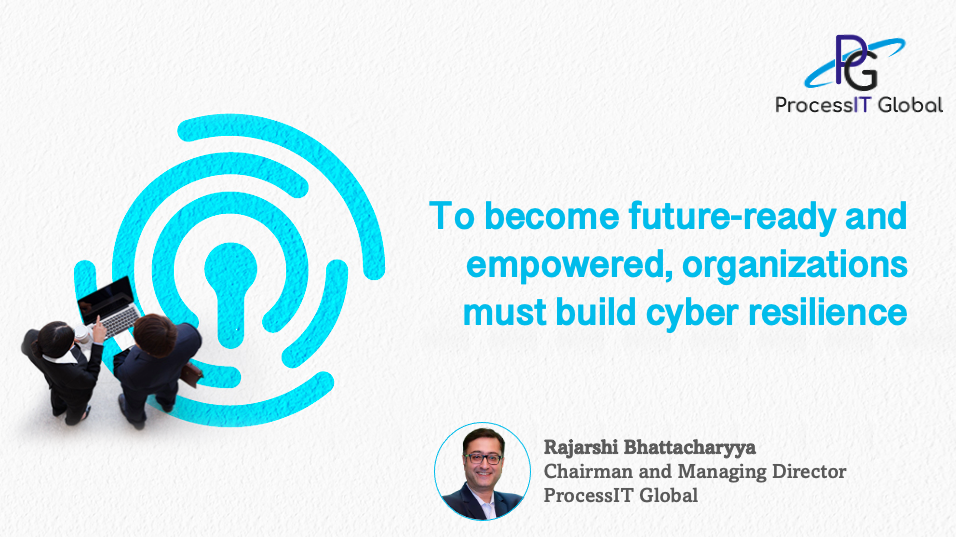To become future-ready and empowered, organizations must build cyber resilience - Rajarshi Bhattacharyya, chairman and Managing Director and ProcessIT Global

Organizations across the globe, as well as
individuals, are emerging from the pandemic setback. Businesses have finally begun to resume their
operations and there is a growing dependency on digital technologies with digital
transformation becoming the ‘new mantra’ to succeed. The emergence of innovative business models
with new-age tools and technologies where exceptional collaborations are
established, is, unfortunately, on the other hand expanding the attack
surface.
In the current times and future days to come, data, the new currency has to be protected at any cost as it drives innovation, operational efficiency, and cost savings. New service offerings are being born every day and delivering exceptional customer experience has become a key priority, as both lead to better business outcomes.
The impact of growing cyber-crimes
Cybercrime causes enormous damage including
monetary loss, massive reputational harm, and reduction in productivity, and even
hurts the competitive edge earlier enjoyed by the organization due to
espionage. National security is
compromised sometimes due to these attacks and the organization’s ability to
grow powerfully is crippled. At times
such cyber-attacks even become a threat to humanity.
Companies face business disruption and have to
further invest in restoring and improving their systems and processes.
Contracts are terminated by customers and client relationships get diluted and
profits fall steeply. A cyber breach
also has legal consequences. Yes, data
protection and privacy laws require the organization to manage the security of
all personal data of customers as well as employees, failing which fines and
sanctions are imposed on them. To combat the wide variety of threats,
organizations have to leverage different products and solutions as no single
solution can address all their cybersecurity needs. Today, organizations have to identify assets
and protect them by integrating best-fit products. Timely detection of attacks and breaches
along with response and recovery has to be ongoing.
According to Cybersecurity Ventures, global cybercrime costs are expected to reach USD 10.5 trillion annually by 2025, where the damage is enormous.
Cyber resilience is a living process
Only cyber security defenses implemented to
secure our businesses and data are inadequate in addressing the cyber attacks
that are on the other hand getting more sophisticated day after day. What organizations require is an ongoing cyber
resilience framework in addition to cyber security measures, as the latter only
focuses on identifying and addressing vulnerabilities, detecting threats, and mitigation
and training employees on defensive tactics.
Over and above this, organizations have to build
resilience across all systems and processes across business units. Priority should be given to brand reputation,
legal and compliance, finance, and customer trust, and ensuring these aspects
are not impacted by cyber-attacks as they are bound to gain high attention and
significance in the event of an attack.
Both IT security and business unit heads are to be zero complacent about cyber resilience and always ensure business continuity is maintained with almost no impact.
Establishing Zero Trust Maturity
The inadequacy of legacy security tools and
technologies is compelling businesses to adopt Zero Trust Architecture (ZTA)
and become cyber resilient. In this
model, no user or entity accessing the organization’s network is trusted as
they could be a potential threat. Any
access request is first assessed, evaluated, authenticated, and verified before
permission is granted.
In a ZTA, the security perimeter evaporates and
the focus here is continuous improvement with cybersecurity solutions which are
also getting refined by the day, leading to Zero Trust Maturity. Both internal
and external threats are identified and addressed with security technologies
that are integrated with entities across the network before any harm is done.
Mature Zero Trust security models are effective
as they lead to the threat surface getting reduced making the attack less
severe.
Built on ongoing monitoring and continuous improvement, the ZTA is all set to improve the security posture at any organization.
With security becoming a business priority, IT security
leaders have to work hand-in-hand with the C-Suite to design and implement the cyber
resilience framework. Employees have to be provided with relevant tools,
technologies, and training to operate effectively in the new business
environment where they are made aware that cyber resilience is a board room
priority.



